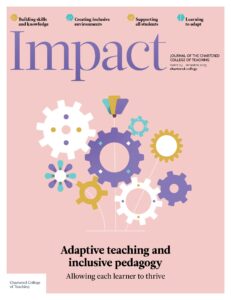Starting strong: Enhancing English competence in disadvantaged early learners in India

SONIKA PARASHAR, ASSISTANT PROFESSOR, SCHOOL OF ARTS AND SCIENCES (TEACHER EDUCATION), AZIM PREMJI UNIVERSITY, INDIA
Introduction
Despite early access to English-medium education under India’s Right of Children to Free and Compulsory Education (RTE) Act 2009, many children from disadvantaged backgrounds struggle to attain proficiency in English. A closer look at the content and strategies used to teach English to these learners finds that they are unrelated to learners’ social context and include minimal opportunity to use the language. Responding to this research gap, this article explores effective early interventions and teaching strategies for enhancing basic communicative competence in English among learners from disadvantaged backgrounds in India. Focusing on early childhood learners at a private school in North Delhi, India, the study aimed to develop context-sensitive teaching strategies and assess their effectiveness. Thirty learners were selected through convenience sampling, and data was gathered using observation and rubrics, then analysed qualitatively using thematic content analysis.
When will her English remedial classes end?’ wailed Anju’s [name changed] flustered mother in her home language – a blend of Hindi and Bhojpuri. Her voice carried the frustration of years spent watching her daughter struggle in school. Despite three years of additional English support classes, Anju remained unable to meet the proficiency expectations for her grade. Returning home late, too tired for homework or play, Anju now bore the stigma of being labelled a ‘weak student’ by her peers.
Anju’s story is emblematic of a broader challenge faced by children from socio-economically disadvantaged backgrounds in India, particularly those enrolled in private English-medium schools through the RTE Act. This landmark legislation reserves 25 per cent of seats in private schools for children from economically weaker backgrounds, offering them early exposure to English-medium education. Yet, as Anju’s case illustrates, access to English as a medium of instruction does not automatically translate into proficiency. Despite six years of English-medium education, Anju, like many others, struggles to achieve even the basic A1 proficiency level defined by the Common European Framework of Reference for Languages.
Background and context
English education in India is a double-edged sword, offering opportunities for social mobility while perpetuating systemic inequities. The proliferation of English-medium schools (Endow, 2015) and the integration of English into early education (Reddy, 2022) reflects societal aspirations for better economic prospects (Suganya and Soundararajan, 2017). However, this trend is also marked by stark disparities in resources and instructional quality. Teachers and students at schools serving affluent communities typically exhibit high levels of English proficiency, while schools catering to marginalised communities face challenges such as underqualified teachers and minimal exposure to English outside the classroom (Selvam and Geetha, 2009).
From a policy perspective, the National Curriculum Framework (National Council of Educational Research and Training, 2005) advocates a shift from rote memorisation to communicative, learner-centred approaches. However, implementation gaps persist. Marginalised learners often encounter teaching practices that are disconnected from their social realities, emphasising grammatical competence over meaningful communication (Agnihotri, 2010).
Challenges in English education
Inadequate resources, large class sizes and untrained teachers hinder effective language instruction for disadvantaged learners (Mosha, 2014; Nguyen et al., 2014; Paradis and Kirova, 2014). Furthermore, the content taught in many schools is often removed from learners’ social contexts, making it difficult for students to relate classroom lessons to their lived experiences. Sociolinguistic, discourse and strategic competencies are frequently neglected in favour of linguistic competence (Hymes, 1972), leaving students ill-equipped to use English in practical, real-world settings.
Learners from low-income families also face limited home support for English acquisition, as parents often lack the resources or proficiency to assist with language learning (Meganathan, 2019). These challenges underscore the urgent need for teaching strategies that are both context-sensitive and student-centred, enabling learners to acquire not just linguistic knowledge but also communicative competence.
Rationale and objectives
This study aims to bridge the gap between policy and practice by developing and evaluating context-sensitive teaching strategies for young learners from disadvantaged backgrounds. Focusing on preschool and pre-primary students in North Delhi, the research seeks to enhance basic communicative competence in English through methods that are tailored to learners’ developmental and social needs. By equipping learners with practical language skills, the study aspires to make English education more equitable and accessible, fostering better academic and social outcomes for all children.
Methodology
This mixed-method study employed descriptive and experimental approaches, targeting preschool and pre-primary children aged four to five+ years from disadvantaged and weaker sections of society in a private school in the North Delhi zone of India, using convenience sampling. The sample comprised 15 preschool learners aged four+ to five years and 15 pre-primary learners aged five+ to <six years, all from disadvantaged backgrounds. Data was collected using observation and rubrics, and analysed qualitatively using thematic content analysis.
Results and discussion
This study focused on formulating and evaluating teaching strategies aimed at fostering the acquisition of basic communicative competence in English among early childhood learners from disadvantaged backgrounds. The study’s findings and accompanying discussion are organised into three subsections: development of teaching strategies, acquisition of basic competence and response to teaching strategies.
Development of teaching strategies
To tailor teaching strategies to learners’ social contexts, experiences, needs and interests, extensive consultations were conducted with various school personnel, including academic and language coordinators, preschool and pre-primary coordinators, the school counsellor and teachers. These interactions, supplemented by learners’ direct observations in their everyday environments, were instrumental in understanding the unique requirements and preferences of children from disadvantaged groups. Insights revealed that learners aged four to six years typically had around five minutes of attention span, necessitating a diverse array of engaging activities to sustain their focus in classroom settings. They preferred interactive activities, especially those involving stories, rhymes, songs and familiar themes. The strategies addressed these needs by integrating relatable topics such as family, nature, animals and surroundings into instruction. Moving beyond rote learning, learner-centred methods such as storytelling, action songs and interactive discussions were implemented in a 15-hour framework, enhancing natural language acquisition effectively. This was also conducted to align with the developmental and contextual needs of early childhood learners and to avoid the usual practice of downward curriculum extension of primary grades, which focuses on reading aloud and copy-writing, typically noted in private preschools (Central Square Foundation, 2016).
Acquisition of basic competence
The effectiveness of teaching strategies was evaluated based on learners’ comprehension and use of target vocabulary, phrases and sentence stems, as well as their ability to follow instructions and engage in interactions, to ascertain the achieved level of basic competence in English.
Vocabulary comprehension and speaking
For pre-primary learners, 53.3 per cent initially comprehended and spoke vocabulary independently, while 46.7 per cent required prompts. Post-intervention, all learners achieved independent comprehension and speaking. Among preschool learners, 47.5 per cent initially comprehended vocabulary independently, 31.4 per cent needed prompts and 21.1 per cent could not. After intervention, independent comprehension rose to 83.6 per cent, with 14.1 per cent needing prompts and only 2.3 per cent unable to comprehend. Independent speaking increased from 29.7 per cent to 81.6 per cent.
Phrases and sentence stems
Pre-primary learners’ independent comprehension of phrases improved from 26.7 per cent to 98.2 per cent, and speaking from 26.7 per cent to 84.9 per cent. For preschool learners, independent comprehension rose from 22.6 per cent to 88.4 per cent, and speaking from 22.2 per cent to 66.7 per cent.
Instruction-following and interaction
Initially, 81.7 per cent of pre-primary learners followed instructions independently, increasing to 88.6 per cent. For preschool learners, this improved from 66.7 per cent to 84.4 per cent. Both groups exhibited enhanced listening, speaking behaviour and turn-taking skills.
These results demonstrate the strategies’ effectiveness in building basic English competence in the context studied, although extended studies are needed to consolidate these outcomes and expand their application.
Response to teaching strategies
The study also assessed learners’ responses to various teaching strategies through observations and feedback from schoolteachers, coordinators and the researcher. Learners’ body language, verbal expressions and engagement during activities provided valuable insights.
Stories
Initially, only 22.5 per cent of learners could independently sustain attention and respond to story-based activities, while 38.6 per cent struggled even with prompts. The integration of voice modulation, actions and visual aids such as puppets significantly improved comprehension and engagement. Contextual stories related to learners’ lives – featuring familiar settings, animals or family dynamics – were most effective. For instance, in the story Bubbles is Lost, learners engaged actively in predicting outcomes and empathising with the protagonist, showcasing their developing ability to connect events and express emotions. By the final stage of intervention, 43.9 per cent of learners could independently retell stories and answer questions, reflecting a notable improvement. The use of repetitive vocabulary and simple sentences helped them to grasp new words while fostering prediction skills and logical thinking.
Rhymes, songs and poems
Songs and action rhymes emerged as the most engaging tools, with learners showing marked improvement in attention and participation. Initially, only 20 per cent of learners could sing or follow taught rhymes independently, increasing to 53.3 per cent after implementing the strategies. Songs with repetitive structures and contextual relevance, such as greetings or expressions of emotion, enabled learners to acquire and practise phrases like ‘Good morning’, ‘How are you?’ and ‘What’s your name?’. Daily exposure to these songs not only reinforced vocabulary but also increased learners’ confidence and willingness to participate.
Speaking activities
Speaking activities such as picture reading, classroom discussions and process-sharing facilitated vocabulary use in meaningful contexts. At the initial level, 15 per cent of learners could participate independently, rising to 40 per cent after intervention. For example, using culturally relevant pictures or engaging learners in describing steps of familiar activities, such as cooking or painting, encouraged expression. Art and craft activities provided a dual benefit by enhancing motor skills while supporting language development through step-by-step instructions.
Language games
Games were particularly effective in channelling learners’ high energy levels and maintaining their focus. Activities involving movement, such as naming colours or animals during physical games, proved highly engaging for preschool learners. These games also provided opportunities for vocabulary reinforcement in dynamic settings. Pre-primary learners responded equally well to a mix of strategies, reflecting their readiness for diverse activities.
Spontaneous conversations
Natural interactions, such as counting chairs or discussing daily routines, emerged as significant for language use. These informal moments allowed learners to practise English in authentic contexts, often demonstrating creative problem-solving and collaboration. For instance, learners calculating class attendance by counting empty chairs highlighted their ability to think critically and articulate ideas using English.
Implications
The research supports the following principles for English language education for disadvantaged early learners in India:
- Focusing on communicative competence rather than only linguistic competence supports building proficiency in a language
- The teaching strategies of language games, stories, rhymes, poems, action songs, speaking activities such as sharing time, classroom discussions, picture reading and process-sharing can not only improve language proficiency, but also make learning engaging and meaningful
- To employ these strategies, the selected materials need to be based on learners’ social context, interests, familiarity with themes, needs and experiences
- Familiarity with learners’ lives, through daily observations and conversations with them in different contexts, regular conversations with their teachers and parents, and an awareness of their community, can help to make the material and strategies context-sensitive
- Language teaching during children’s early years needs to situate itself within the paradigm of language acquisition to provide opportunities for learners to have a ‘silent period’ for listening and absorption – and spontaneous response – without giving undue focus to production of language in the conventional approaches of reading and writing.
References
- Agnihotri RK (2010) Multilinguality and the teaching of English in India. The EFL Journal 1(1): 1–13.
- Central Square Foundation (2016) Pre-Primary Sections in Government Schools: Current Landscape and Recommendations. New Delhi: Central Square Foundation.
- Endow T (2015) English-medium low-cost private schools: How are the children learning? Indian Journal of Human Development 9(2): 261–268.
- Hymes DH (1972) On communicative competence. In: Pride JB and Holmes J (eds) Sociolinguistics: Selected Readings. Harmondsworth: Penguin, pp. 269–293.
- Meganathan R (2019) Research in English language education in India. Indian Educational Review 57(2): 7–72.
- Mosha MA (2014) Factors affecting students’ performance in English language in Zanzibar rural and urban secondary schools. Journal of Education and Practice 5(35): 4–76.
- National Council of Educational Research and Training (2005) National Curriculum Framework 2005. New Delhi: NCERT.
- Nguyen HT, Warren W and Fehring H (2014) Factors affecting English language teaching and learning in higher education. English Language Teaching 7(8): 94–105.
- Paradis J and Kirova A (2014) English second-language learners in preschool: Profile effects in their English abilities and the role of home language environment. Language Development in Multilingual Environments 38(4): 342–349.
- Reddy YS (2022) A descriptive study on teaching of English in non-English medium schools in Telangana. International Journal of Advanced Research in Science, Communication and Technology 2(1): 341–346.
- Selvam S and Geetha V (2009) Textbook Regimes – Tamil Nadu: A Feminist Critique of Nation and Identity. New Delhi: Nirantar.
- Suganya M and Soundararajan R (2017) India learners’ motivation to learn linguistics as a foreign language. Asian Review of Social Sciences 6(1): 10–19.










